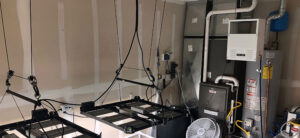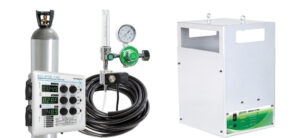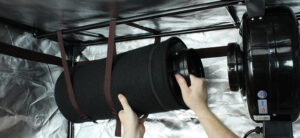
Learning how to control humidity in a grow tent is an essential part of indoor growing.
Your plants need a very specific moisture content to thrive, and its not always easy to keep this metric in the ideal range.
We’ll cover how to raise and lower humidity in your grow tent. But first, we want to quickly talk about the growing environment, and why ideal humidity is so important.
Why Does Humidity Control Matter?
If you don’t control humidity in your grow tent, your plants will suffer. Both ends of the spectrum can cause problems.
If humidity is too high, your plants are much more susceptible to mold and mildew issues. These can quickly spread in a grow tent, and ruin an entire crop.
Excess humidity also will mess with nutrient uptake. This is because the stomata in your plant’s foliage will sense that there is plenty of moisture in the air, and it will stop taking up moisture through the roots.
Since this is where you apply your nutrients, nutrient uptake will cease as well. This leads to a stall or lag in plant growth, and can lead to deficiencies.
Not enough moisture on the other hand, and your plants will dry out and become more prone to heat stress. So, on either end of the spectrum, you'll run into issues and your plants won't be able to thrive.
This is why controlling humidity in grow tent is so important. We'll cover how you can do this in a bit, but first, let's cover the optimal humidity range across different stages of plant growth.
What Is The Ideal Humidity Range?
In general, plants prefer a slightly humid environment. This range changes across the plants different stages of life, however.
Plants like higher moisture levels during seedling and early veg, and this range will taper off to the lower end over its life. Here are some guidelines for grow tent humidity across the different phases:
- Seedling/early veg: 70-75%
- Veg: 50-70%
- Flower: 40-50%
Does Temperature Affect The Ideal Humidity Range?
As you may assume, temperature does in fact play a role in where you should keep your humidity.
To get a better understanding of this relationship, we highly recommend you check out our guide on vapor pressure deficit. It will also help you get a grasp of the ideal humidity range across different stages of plant growth.
The Best Ways To Control Humidity In A Grow Tent
The best ways to control grow tent humidity are with a good ventilation system and/or a dehumidifier.
Set Up Your Ventilation System
You should have a ventilation system setup in your grow tent from the start. Its the easiest way to dial in humidity, and prevent issues with excess moisture from ever occurring in the first place.
We consider ventilation to be an essential component in any grow tent, which is why we include one with each of our grow tent kits.

You can set it up on a timer, so the air in your tent is exhausted every 5-10 minutes.
Or, you can just leave your exhaust system running 24/7. This is an especially good tactic to use during flower, as it will help cut back on the odor and extra moisture created.
You can learn all about how to setup your grow tent ventilation system here.
You can also quickly bring humidity down with a small clip-on fan. These are pretty much a grow tent essential, as stale, stagnant air creates a breeding ground for molds and mildew.
You can also improve the strength of your plants by using one of these. We consider them an essential for any grow tent grower, just like a ventilation system.
But sometimes, even these two air movement mechanisms still aren't enough to bring humidity levels down. In this case, a small dehumidifier is likely your best bet.
Use A Grow Tent Dehumidifier To Decrease Moisture
Most grow tent growers won’t need a dehumidifier, but in instances where your plants become very bushy/crowded, you may struggle to keep moisture down.
While you may think of dehumidifiers as a more commercial intervention for humidity, there are actually dehu’s specifically geared towards hobby growers. Many of these also offer air conditioning, helping you manage grow tent heat simultaneously!
Portable dehumidifiers are great for grow tent growing if you have the extra space. They can work for growers looking to remove as little as 30 pints a day all the way up to 180+ pints - there truly is a unit for every size grower. Here are some of the best:
- Ideal-Air Portable Dehumidifier (30, 50, 80, 120 pints per day options)
- Ideal-Air Pro Series Dehumidifier (60, 100, 180 pints per day options)
- Aura Systems Portable Dehumidifier (180 pints per day)
- Active Air Dehumidifier (110, 190 pints per day)
- Quest Hi-E Dry Dehumidifier (192 pints per day)
If you aren't sure which dehumidifier is right for your grow room, check out our guide on choosing and sizing a dehumidifier.
How To Raise Humidity In Grow Tents
Most of the time, growers will struggle with lowering grow tent humidity rather than raising it. But, there are certainly instances where growers need to increase humidity in their tent.
In these instances, there are a few options. The quickest way is to tweak your ventilation system. Try increasing the time between cycles, so aren't sucking moisture out of the tent as quickly.
You can also leave a reservoir with water in your tent and have a clip on fan blow across it. This is more of a shotgun approach to increasing moisture content, as you won't really have a way to automate this.
You'll have to constantly turn it on/off upon monitoring the current conditions. Plus, it can easily get out of hand and create issues with mold/mildew.
A better approach is to use a grow tent humidifier. Just like dehumidifiers, these are commonplace in commercial grow settings, but they also have a role in the hobby growers arsenal.
For example, the Ideal-Air Commercial Grade Humidifier comes in two options: 75 pints & 200 pints.
While the latter is likely overkill for more grow tent growers, the 75 pint per day unit can really help you increase moisture if your tent is too dry.
Final Thoughts On How To Control Humidity In Grow Tents
By simply setting up your ventilation system from the start, you shouldn’t ever struggle too much with humidity as long as you don’t overwater or leave runoff sitting in your tent. If you need a specific recommendation, our list of the best inline fans for grow tents is a great resource.
But, if things do get out of control, you can easily remedy the situation by investing in a small-scale dehumidifier. Now that you know how to control humidity in a grow tent, you shouldn't ever have to worry!
If you aren’t sure what your best option for managing grow tent humidity is, reach out to our experts at 888-815-9763 or by email here.




















